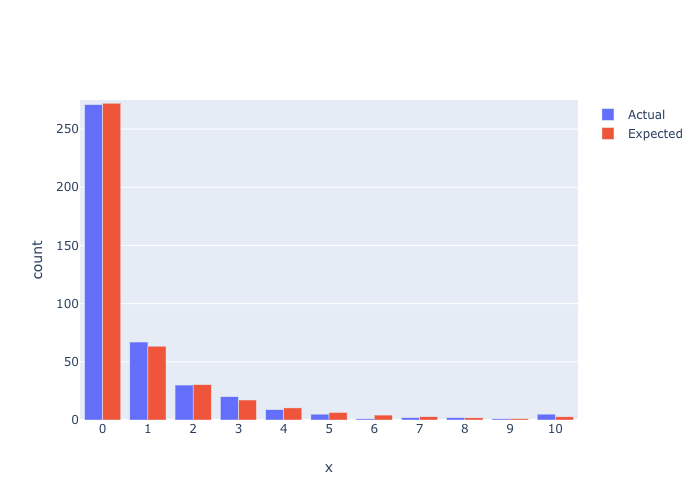Negative-binomial
For modeling count data..
import numpy as np
import pandas as pd
from scipy.optimize import minimize
import os
from IPython.display import display, Image
import plotly.graph_objs as go
def compute_probabilities(alpha, r, t, num_bins):
'''Compute the probability of a person landing in one of the discrete buckets'''
p = [(alpha / (alpha + t))**r]
for x in range(1, num_bins-1):
p.append(t * (r + x - 1) / x / (alpha + t) * p[x-1])
# add remaining probability to right censored cell
p.append(1 - np.sum(p))
return p
def log_likelihood(alpha, r, t, values, counts):
'''Objective function that we need to maximize to get best alpha and r params'''
if alpha <= 0 or r <= 0:
return -99999
probabilities = np.array(compute_probabilities(alpha, r, t, len(values)))
return np.sum(np.log(probabilities) * np.array(counts))
def maximize(values, counts):
'''Maximize log-likelihood by searching for best (alpha, r) combination'''
func = lambda x: -log_likelihood(x[0], x[1], 1, values, counts)
x0 = np.array([100., 100.])
res = minimize(func, x0, method='Nelder-Mead', options={'xtol': 1e-8, 'disp': False})
return res.x
def forecast(values, counts, t):
'''Fits the nBD model to the data'''
# Generate best alpha, r
alpha, r = maximize(values, counts)
# Calculate probabilities
probabilities = compute_probabilities(alpha, r, t, len(values))
# Scale expectations to population
return probabilities * np.array([np.sum(counts)] * len(probabilities))
def fixed_forecast(values, counts, alpha, r, t):
'''Forecasts with fixed alpha and r obtained from initial fit'''
# Calculate probabilities
probabilities = compute_probabilities(alpha, r, t, len(values))
# Scale expectations to population
return probabilities * np.array([np.sum(counts)] * len(probabilities))
df = pd.read_csv('../data/barchart-1.csv').iloc[:, :2]
# in-sample fit
forecast_series = forecast(df['values'], df['actual'], 1)
insample_df = (
pd.DataFrame({'values': np.arange(0.0, 11.0),
'expected': forecast_series})
.merge(df, on='values')
.assign(
chi_sq=lambda x: np.abs(x['actual'] - x['expected']) / x['actual']
)
)
insample_df
fig = go.Figure(data=[
go.Bar(name='Actual', x=insample_df['values'], y=insample_df['actual']),
go.Bar(name='Expected', x=insample_df['values'], y=insample_df['expected'])
])
fig.update_layout(title='',
xaxis_title='x',
yaxis_title='count',
annotations=[
],
xaxis = dict(
tickmode = 'linear',
tick0 = 0,
dtick = 1
)
)
# Change the bar mode
fig.update_layout(barmode='group')
fig.update_yaxes(range=[0, 275])
fig.show()
Image(filename='../images/nbd-figure-1.png')

